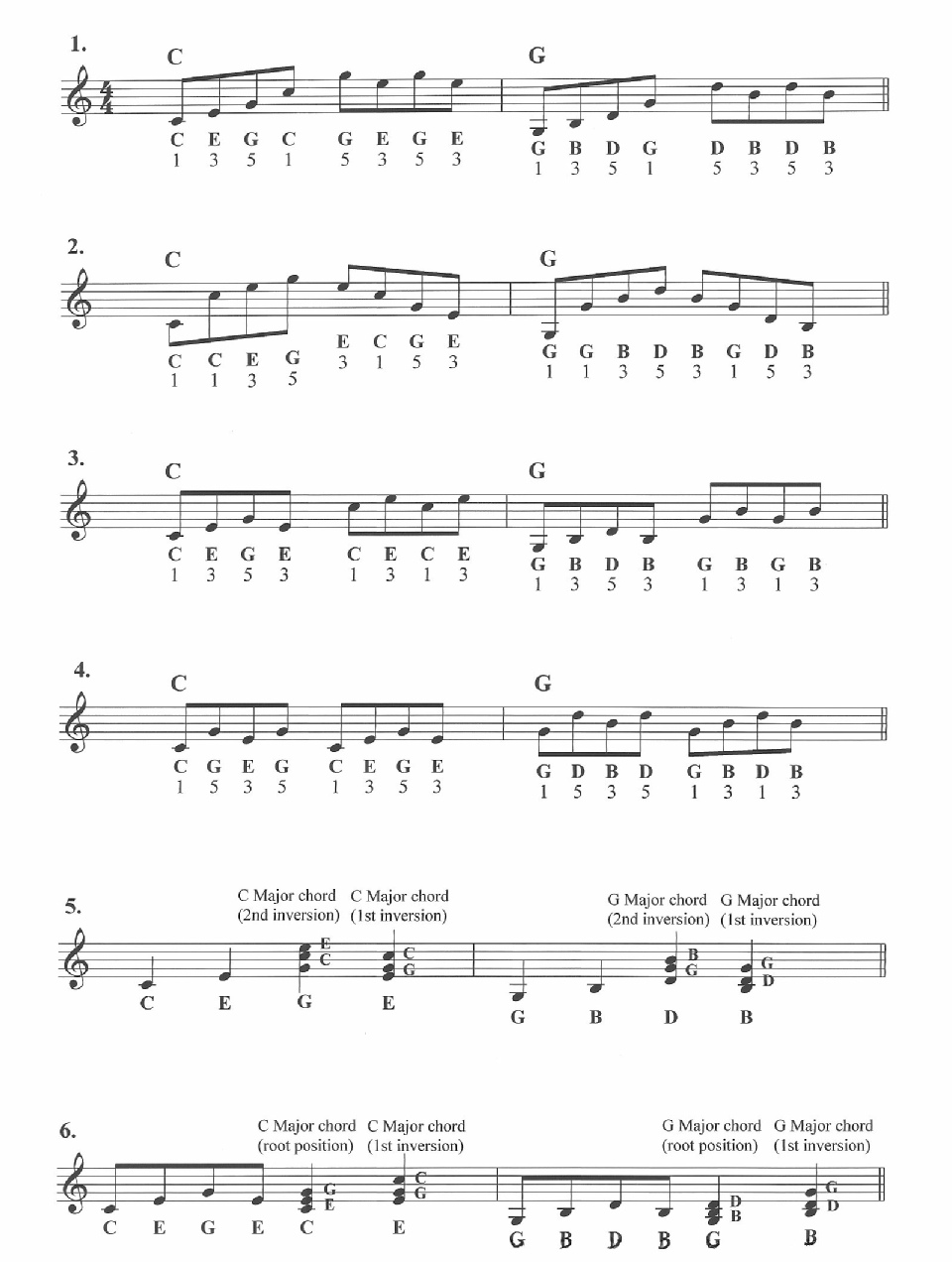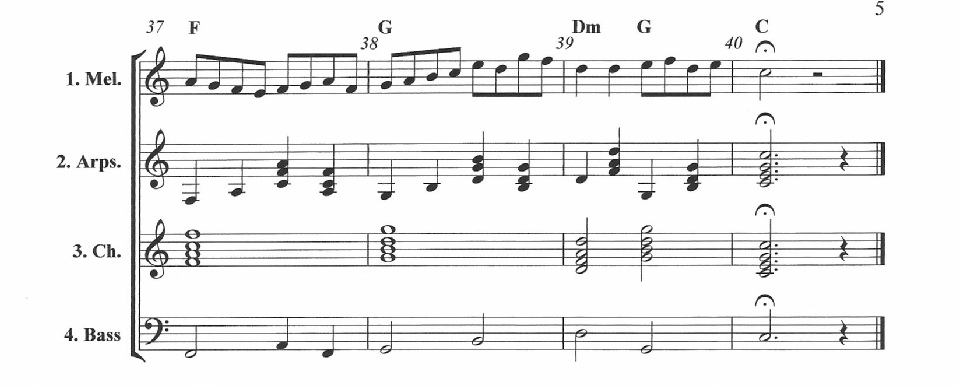









If you haven’t already made a note of the chords you might use to accompany your piece based on the notes of your melody, do this now (note my chord selections above each bar on the music on page 44 of the book). Notice also that some bars have two chords; you can of course use more than one chord in each bar, but don’t try to be too clever as you could make the music sound hectic.

Striking a Chord - Chords in Root Position
In my piece I used several straightforward root position chords (chords which have the letter name (the root note) of the chord as the lowest note – e.g. a C major chord will have the note C as its lowest note). To add depth to the sound, I doubled the root note at the top of each chord to make a four note chord (with only three different notes). Using these basic root position chords the first 8 bars of my piece looked like this when harmonised (see below):


Adding Accompaniment Parts (to a melody)
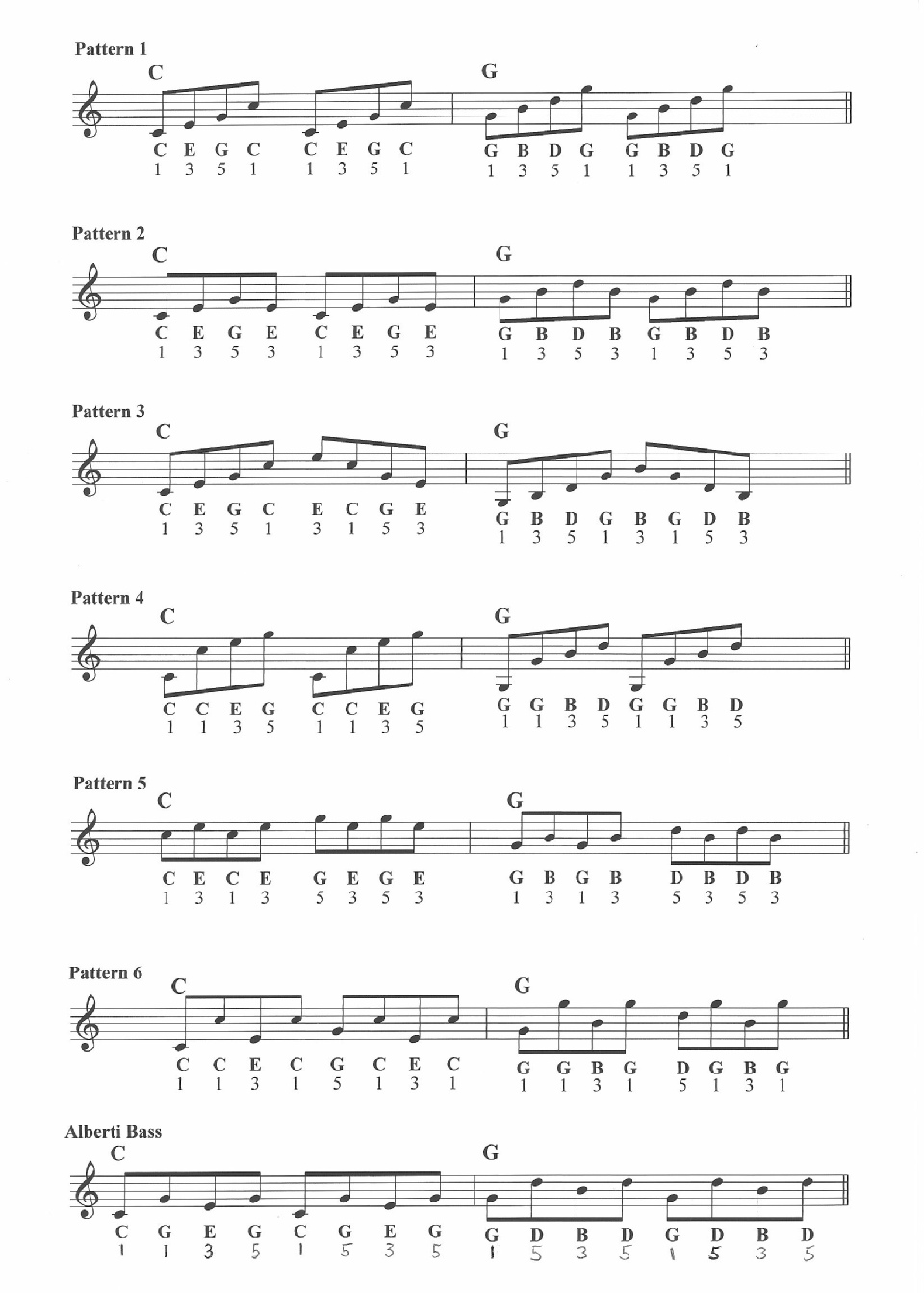

And it’s possible to make the bass part even more interesting…

However, having one bass note in each bar could start to sound a bit too repetitive after a while, in which case you can experiment by adding other notes of the accompaniment chord – for instance, E and G (from C, E, G) if the accompaniment chord is C major, and B and D (from G, B, D) if the accompaniment chord is G major.
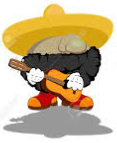

A word about bass notes and chord inversions…
‘Whenever you have just a single bass note in a bar of music it must be the same as the lowest note of the accompaniment chord in that bar. You need to be aware of this if you have used chord inversions in some of your accompaniment chords (see above), otherwise you will cancel out the effect of the chord inversion. For example, if you have used a G major chord in first inversion, the bottom note of the chord will be B (from G, B, D), so the bass note will also have to be a B in order to give you the sound of the G major chord in its first inversion.’


‘Simply altering the pitch of your bass notes by making them an octave higher or lower than your first choice (or even two octaves higher or lower) will create subtle new sounds. A very low bass note, for instance, can produce the kind of deep resonance that will enhance your composition.’


As we have already chosen chords to accompany our pieces, composing a bass part will be straightforward since we can use those chords to guide us with bass note selection.
In a simple bass part a single note (pedal) can be used in each bar, taken from the letter name (the root note) of the chord used in the accompaniment. For example, if a C major chord is used in the accompaniment, a single C note can be used in the bass, and if a G major chord is used in the accompaniment, a single G note can be used in the bass.




Try some of the above broken chord patterns using different chords. To do this, you just need to copy the note pattern (the ordering of notes 1, 3 or 5) no matter which three-note chord (triad) you use.

Ex.3 Common Broken Chord/Arpeggio Patterns

These patterns can of course be combined with each other, and with basic 'unbroken' or block chords, to create other interesting accompaniments.

After some experimenting with these accompaniment patterns, I decided to get creative and use several varieties in my piece, including arpeggios (Common Patterns 1, 3 and 5 above) and Combination Patterns 1 and 5 above. You can see all of these ‘at work’ in the arpeggio accompaniment part of my full piece, the music for which is shown below.




Experiment with the various accompaniment patterns we have just examined and see which sound best with your own composition. Why not also try making some of your own patterns? You can stick with the same pattern all the way through or, like me, use a few different ones or add some combinations. Above all, have fun with this exercise!


‘Arpeggios have the useful effect of helping a melody flow smoothly – which is one reason why a lot of solo singers use them to accompany themselves on piano or guitar.
‘The guitar and the piano are popular instruments with solo singers not only for their sound but because they are harmonic instruments – meaning they can play several notes, including a melody and accompaniment, simultaneously.’

Examine my finished piece below while you listen to it on CD track 22 of How to Pass National 5 Music. All of the techniques described above are indicated on the score wherever they are used. Notice how I have kept the bass part under control, yet given it enough movement and variation to make it interesting. You will also notice that I have added dynamics to the music; these maximise the effect of musical features such as key changes, new sections and ascending/descending melodies, giving extra depth and character to the music.




Have a go at writing a bass part now to complete your piece, keeping in mind everything you have learned in this section – especially concerning not making the bass too busy! Experiment with chord notes, passing notes, auxiliary notes, walking bass, contrary motion, pedal and different bass rhythms to create countermelody. Listen carefully to how each bar in the bass part sounds with the other parts; does it complement the rest of the music or distract your attention away from the main melody? Not using too many bass notes is good practice, but keeping the volume (dynamic) of the bass part down will also help to prevent it from becoming overpowering.
Remember…simplicity might produce a better result!

Congratulations!
You have completed a well-structured piece of four-part instrumental music. Well done!
Whether or not you used a sequencer to assist in the composing process (as I did), you now have an original piece of music that can be performed ‘live’ on four different musical instruments. The melody and arpeggio parts, for example, can be played on instruments capable of playing notes within the pitch range of the treble clef (e.g. flute, clarinet, violin, recorder, trumpet, guitar, harp, keyboard, synthesizer); the chord part will have to be played on a harmonic instrument such as the piano, keyboard or guitar; and the bass part might be given to a cello, double bass or bass guitar. The decision is all yours.
Armed with the composing techniques we have examined in this unit and your own inspiration, there is nothing to stop you from going on to create more impressive pieces of music – which will only continue to improve as you gain experience with the techniques.
Above all, composing should be an enjoyable and rewarding activity. Every piece you compose is a unique achievement with the potential to amaze all who listen to it.
Especially those who don’t know the special composers' techniques...!


Caution!
You do need to be careful not to add too many notes to your bass part as doing so can easily interfere with the clarity of the main melody, making your piece sound cluttered with notes. As always, listen carefully to each step you compose and use your natural instincts to guide you in what sounds good as you experiment with various possibilities.
Sometimes simplest is best!
Here is an effective little technique that can help to keep your bass part under control:
Here is how I used this technique in bars 19 and 24 of my piece (see below):

If the melody is active, use a less active bass part;
If the melody is less active, use an active bass part.


How to Pass National 5 Music, Composing Workshop 1 (page 45)




For some practice with chord inversions, write out chords I, IV, V and VI in the key of F major in root position and in first and second inversion. When you have done this, try playing the chords to hear their unique sound character. Then, if you like, include some chord inversions in your own composition.

Later on, in the arpeggio accompaniment part, (bars 33-39) I used chord inversions.
Chord Inversions
A basic chord is made up of three notes (called a triad): the first, third and fifth notes of that chord’s scale. For example, in the scale of C major, the first note is C, the third note is E, and the fifth note is G. So the chord of C major is constructed with C at the bottom, E in the middle, and G at the top. This is the chord in root position. A chord inversion involves replacing the bottom note of the root position chord with one of the other notes. These are known as first inversions and second inversions. For example (see below):

Audio Example 2. Click ‘play’ to hear the example below

Ex.2 Chords in root position, first inversion and second inversion

Note: This of course applies to all chords in all keys

Other Forms of Chord Accompaniment

Broken Chords
Now that we have selected our chords, there are a few ways in which these can be used to accompany our melodies. We have already added basic chords (sometimes also called ‘block’ chords), but we can ‘break up’ the notes in these chords to create various arpeggio patterns or an Alberti bass.
Below are some common arpeggio patterns and an Alberti bass, formed from the notes of a C major chord and a G major chord. (The numbers indicate the notes taken from the C major scale and the G major scale; whether 1st, 3rd or 5th). Notice how the three notes of each chord (C, E and G, and G, B and D) are arranged into patterns that can be repeated with the notes of any chord.


This page examines various straightforward techniques for creating accompaniments and bass parts for a melody. clicking on a link below will take you directly to that particular section.

Audio Example 1. Click ‘play’ to hear the example below

Ex.1 First 8 bars of music with chord accompaniment


Audio Example 3. Click ‘play’ to hear the examples below

Audio Example 4. Click ‘play’ to hear the examples below

Update RequiredTo play the media you will need to either update your browser to a recent version or update your
Flash plugin.

Ex.4 Combination Patterns
Audio Example 5. Click ‘play’ to hear the example below


Update RequiredTo play the media you will need to either update your browser to a recent version or update your
Flash plugin.
Audio Example 6. Click ‘play’ to hear the example below


Ex. 6 Bass Part Using Other Chord Notes
Update RequiredTo play the media you will need to either update your browser to a recent version or update your
Flash plugin.


The composing techniques which helped to develop the melody for this piece can also be effective for its bass part. As well as adding extra chord notes, we can use passing notes, auxiliary notes and vary the basic rhythm in some bars. What’s more, using a combination of these techniques can quickly (and easily) produce a more complex countermelody.
Other musical concepts that could develop the bass texture are:
* Walking bass
* Ostinato or Ground bass
* Contrary motion
Let’s look at how all of these concepts and techniques might be used in the bass part of the first four bars of my piece (see below):
Walking Bass
(Created with chord notes played in a repetitive rhythm using minims or whole notes)
Audio Examples 7 - 10. Click ‘play’ to hear the examples below

Update RequiredTo play the media you will need to either update your browser to a recent version or update your
Flash plugin.
Audio Example 11. Click ‘play’ to hear the example below

- Ex.11 BALANCING MELODY AND BASS
Update RequiredTo play the media you will need to either update your browser to a recent version or update your
Flash plugin.

Ex.11 Balancing Melody and Bass

Nearly There…
Now we only have one, very important part left to compose; one which will give the music real depth – a sort of three-dimensional sound. The bass line.


Note: So far I have used two separate accompaniment parts in my piece based on 'block' chords and arpeggios. I didn’t need to have both, but the block chords can be played on a harmonic instrument like the piano, keyboard or guitar, whilst the arpeggios might be performed on a number of possible instruments. Having both types of accompaniment therefore adds to the texture of the composition.
Update RequiredTo play the media you will need to either update your browser to a recent version or update your
Flash plugin.
Update RequiredTo play the media you will need to either update your browser to a recent version or update your
Flash plugin.
Update RequiredTo play the media you will need to either update your browser to a recent version or update your
Flash plugin.

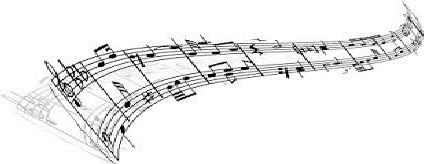
Adding Accompaniment Parts (to a melody)
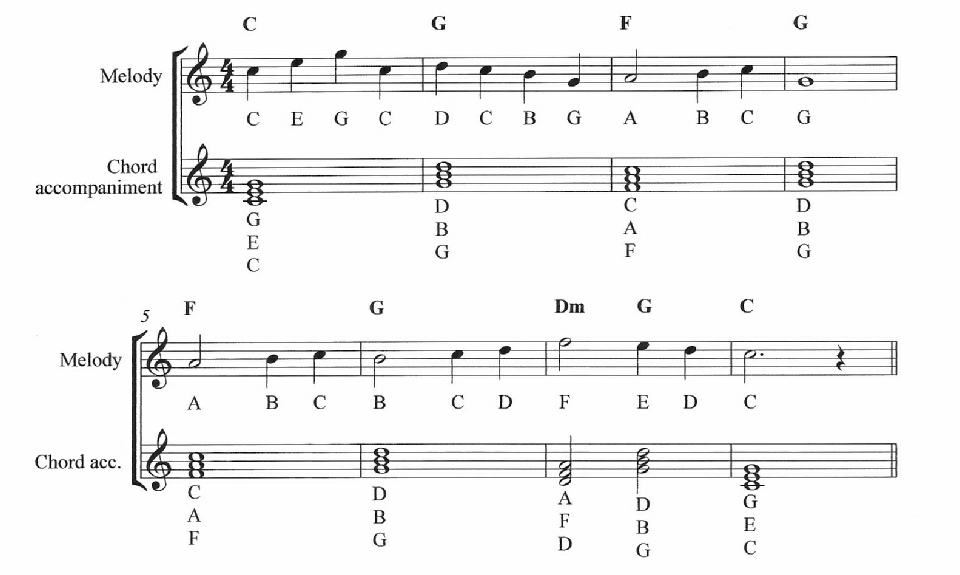




Ex.7 Walking Bass
Created with chord notes played in a repetitive rhythm (minims or half notes)
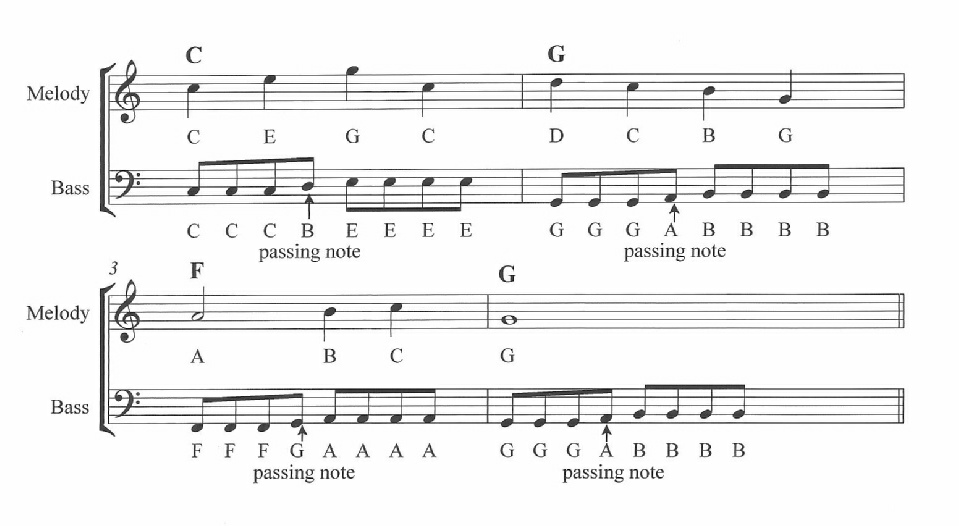

Ex.8 Ostinato (with passing notes) or Ground Bass
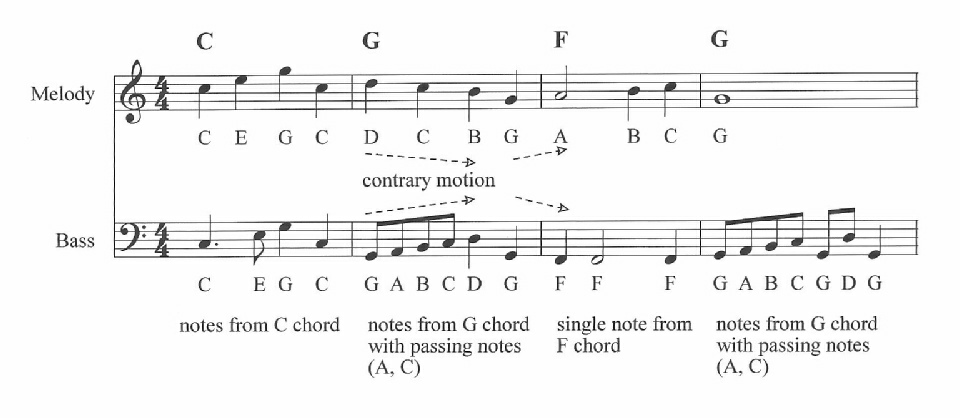

Ex.9 Chord notes, single bass notes, passing notes, rhythm variation, contrary motion (all creating countermelody)
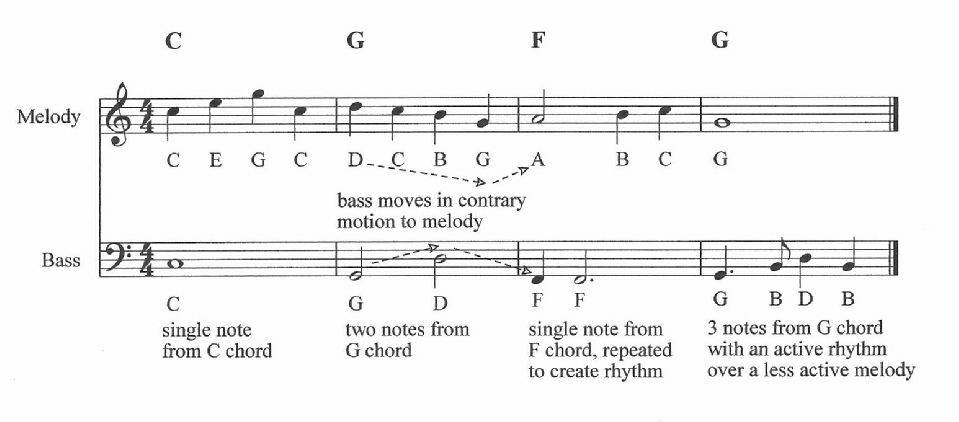

Ex.10 Chord notes, single bass notes, contrary motion, rhythm variation, active bass rhythm over less active melody (all creating countermelody)








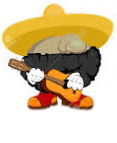



‘When choosing a chord to accompany a note or a bar, you may find it easier to select one which has a note in common with the note(s) you are harmonising. For example, in the key of C major, a C note in your melody could be harmonised with the chords of C major, F major or A minor, because each of these three chords contain the note C. This is not a strict rule, since some other chords will sound okay when played with a C note, but unless you are more experienced, use this basic rule and you won’t go wrong! Whatever you do, use your ear to guide you in what sounds best.’

